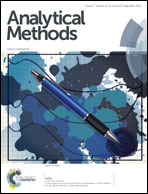Metabolites of Rehmannia glutinosa Libosch extract by intestinal bacteria from normal and chronic kidney disease rats in vitro
Abstract
Rehmannia glutinosa Libosch is a traditional Chinese medicine clinically applied to treat kidney disease for thousands of years. However, the interaction between the herb medicine and the gut microbiome remains unknown. In this study, a rapid automated analysis method, ultra-performance liquid chromatography/quadrupole-time-of-flight mass spectrometry (UPLC-Q/TOF MS) technique combined with Metabolynx™ software, was first established and successfully applied for screening and identification of the metabolites of the main bioactive components in Rehmannia glutinosa extract by intestinal bacteria from normal and chronic kidney disease (CKD) rat feces. When compared with blank samples, the two parent compounds (catalpol and acteoside) plus six metabolites were detected in the two groups of bacterial samples. Catalpol was first deglycosylated to its aglycone and subsequently to hydrogenated catalpol aglycone. Acteoside was converted to the De-caffeic acid moieties acteoside, hydroxytyrosol, and considerable amounts of caffeic acid. The latter was methylated to the corresponding caffeic acid methyl ester. Caffeic acid and its methylated product were the main metabolites. However, compared with the model group, intestinal bacteria from normal rats showed stronger metabolism capability and larger amounts of the metabolites were detected. These results will be helpful for the further investigation of the pharmacokinetic study of Rehmannia glutinosa Libosch in vivo.


 Please wait while we load your content...
Please wait while we load your content...